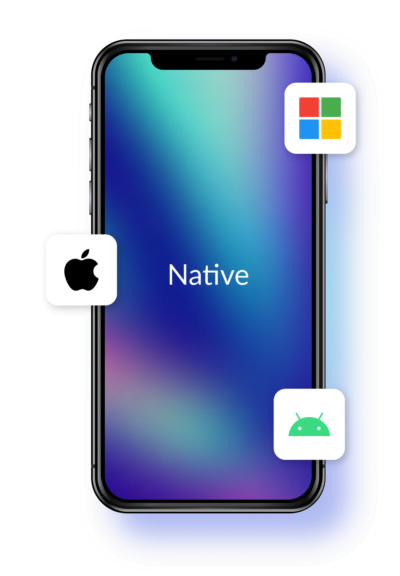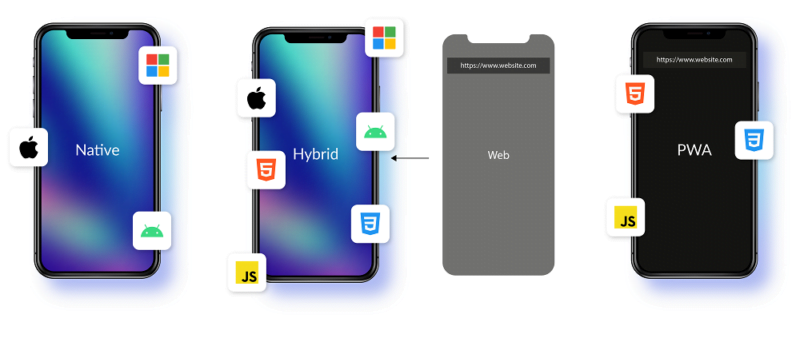Reading Time : 1 Mins
Hybrid, Native or PWA – What type of Mobile App is Best for My Business?
Loves getting creative with mundane topics in addition to geeking out over books and movies.
Mobile phone users today want everything literally at their fingertips. If a brand does not have a mobile presence, the chances are that its customers will soon lose interest in the brand. From the consumer perspective, the different types of mobile apps available are a great way to shop, search for information, stay connected, and do so much more. For businesses, mobile applications are a great way to keep customers engaged and build loyalty. Various types of mobile apps can also be used to upsell, making the mobile app experience a vital business requirement.
So would a basic native app be sufficient to meet your business goals? Probably not.
Today, businesses can choose from various types of mobile apps in terms of design and development. They can choose from using web technologies for hybrid apps, leverage the benefits of cross-platform apps, or choose the more progressive web apps (PWAs).
You need to be able to make the right decision about what type of mobile application – PWA, native or hybrid – will work best for your business, and can be easily integrated to offer the best mobility experience to your customers. Designing and developing a mobile app can be a complex and multifaceted process, and requires several difficult decisions along the way. And one of these difficult decisions is to pick what type of mobile application you should build. As luck would have it, there is simply no right answer that would universally apply in all cases.
But let’s look at the different types of apps in mobiles and explore their best features and drawbacks to understand what type of mobile app matters most for your business and user experience.

Native Apps vs. Hybrid Apps vs. PWA
What are Native Apps?
They may not be glamorous, but native apps offer superior performance, app stability, and simplicity as compared to other types of mobile applications. That’s why they are best suited for complex graphics-intensive apps such as gaming or video streaming apps that require a fluid user experience. However, native apps are not easy to build and cost a lot of money and time to build.

Features
- Designed and built for specific operating systems, including Android or iOS
- Convenient for standard graphic design and user interface development
- Inbuilt support for hardware and software devices to increase app responsiveness
- Easy adaptability with inbuilt features such as camera, microphones, GPS, and special abilities
- Shorter learning curve as developers may already be aware of what’s required
- The software development kit (SDK) is easily available, while ready-made solutions, libraries, and tools shared by communities offer a similar objective
Benefits
- Better optimization of device resources and performance
- Allows mobile app developers to retain native look and feel
- Ideal for gaming/ streaming apps
- No requirements for plugins to add features like GPS, cameras, and microphones
- Performs well even in the absence of internet connectivity or low connectivity
- Native Apps better utilize the device’s resources
- Native apps make it easier to retain the platform’s native look-and-feel
- Native apps give developers full access to all the functionalities offered by the SDK
- Native applications are typically designed in a way that allows users to use them without access to the internet or with bad connectivity. This may be especially important for users in roaming, where additional data costs apply
Cons
- Highly expensive
- Incompatible with different versions of operating systems
- High development skills in both Android and iOS development
- When the app has to be supported by multiple platforms, native app development entails running separate development processes, which takes longer
- The above probably means higher costs due to engaging multiple developer teams. Native is not the most efficient approach and requires maintaining a distributed codebase
- It is expensive to maintain in the long term due to the need to push out updates for multiple mobile platforms
What are Hybrid Apps?
Think of hybrid apps as a blend of native and web mobile technology. They offer the best of both worlds: the familiar installation process through the device’s app store, and compatibility with multiple mobile platforms. These types of mobile apps are compatible with multiple platforms and can be installed easily through any of the major mobile app stores. Most hybrid apps come integrated with platform-specific plugins and are thus able to offer native-like experiences bridging the gap between native technology and the web.

Features
- Easy development with programming codes used are HTML, CSS, and JavaScript
- Apache’s Cordova platform allows transitioning of a responsive website into mobile apps
Pros
- Various apps built using hybrid technology use Cordova as a platform. Cordova wraps around HTML5/JavaScript and can run on its interface known as a WebView. It also enables easy access to a device’s functions and hardware
- Hybrid apps use a single code base for all mobile platforms, which lowers design costs, shortens the time involved in mobile app development, and reduces the cost of maintenance
- Easy and fast development process for application
- Hybrid apps have PWA app features embedded which means they can also function offline
- Hybrid mobile apps come with responsive web design. This allows them to work with a variety of mobile operating systems easily
- Hybrid apps can act like native apps, enabling them to be installed from app stores and viewed on mobile browsers, or even be distributed natively, allowing app developers to reach a wider audience
- It is easier for app owners to test hybrid apps. The best part is that there’s no need to perform tests separately for iOS and Android, which means a shorter time to launch the mobile app in the market
Cons
- Hybrid apps suffer from lack of optimization which impacts their performance
- UI/UX standards are not up to the mark
- Various apps are often unable to function like native apps
- Updates in the underlying technology are not readily available due to the lack of a large developer community and library support
- In the offline mode, some functions of a hybrid app may not be available
What are Progressive Web Apps?
Progressive web apps, or PWAs, are types of mobile apps that run on browsers. PWAs mimic the functions and characteristics of a native application providing the user with a native-like experience. But these types of mobile apps are designed and built on the web and are popular for their easy installation and low reliance on Internet access. PWAs can be installed with a single click and can use the same code base across the mobile desktop. PWA’s are based on web technologies, which allows them to be distributed without packaging or signing.
Don’t miss reading What are the top PWA frameworks for developing Progressive Web Apps?

Features
- PWAs are hosted on a server
- They are distributed using URLs instead of via app stores
- Users can find PWAs easily using search engines
- Shortcuts to a user’s most used PWAs can be added to the home screen of their device using the ‘Add To Homescreen‘ tag, which eliminates the need to install from the app store. However, the PWA will still function like an installed app
- Hybrid app development requires both web app and native app development skills, such as Kotlin/Java for Android and Swift for iOS. But because PWA apps have a single code base any developed skilled in web development can create a PWA
- PWA apps are known to work equally well even in low Internet connectivity
Pros
- PWAs are cheaper to build and distribute as there are no app store expenses
- They are embedded with service workers to work offline
- As compared to other types of mobile apps, PWAs are more interactive
- Mobile app developers find it easier to develop features like instant messaging, push notifications, webmail online sales, etc.
- There is also no explicit app update action required from the user. PWAs update automatically, ensuring that users always have the latest version
- It is also easier for mobile app developers to transition an app programmed with Angular, React.js, and Vue.js into a mobile app
- Faster app development because the main programming languages involved are HTML, PHP, CSS, and JavaScript
- PWAs are the most responsive type of apps, as they are compatible with different screen sizes
- PWAs can also be distributed through the app store if required
Cons
- Some features of PWAs don’t work as well on iOS devices. For instance, there are no push notifications on iOS. Also, on an iPad, a PWA does not enable split or side views like native apps
- PWAs do not perform as well as native apps
- No scopes for code programming in the backend
- Due to there very nature, PWAs cannot access the user’s phone contacts and location, unlike native apps. Other device features like the camera, fingerprint reader, etc. are also usually not accessible to a PWA
Let’s do a quick comparison between Hybrid, Native and PWA styles:
| Criteria | Native | PWA | Hybrid |
| Code Reusability | Complex Coding | Write Once | Write Once |
| Performance | Fast | Better speed than hybrid | Slower than native |
| Popularity | Most popular, used by likes of Facebook | Highest reach with companies like Flipkart,Twitter Lite | Popular for everyday apps like Instagaram,Gmail |
| Distribution | App Store | URL/Add to Home Screen | App Store |
| Cost | High | Low | Moderate |

So Which Type of Mobile App Should You Choose?
Honestly, there is no right answer. As we’ve seen here with different types of apps in mobile devices, every type has its own pros and cons. As you compare them in terms of their performance and cost-effectiveness, native apps seem to lead. However, PWAs also offer flexibility, while Hybrid apps offer faster development benefits.
Also check out this short video where our Senior Software Engineer, Sanjeev Karat gives an overview of these development approaches.
If you’re still finding it difficult to decide, you can check out this app development guide and then list out what you want your app to do for your business and what type of app will best meet the expectations of your target audience. You can also Match that list against the benefits and disadvantages of various apps and go with what works best for what you plan to offer. Here are some questions you could ask your mobile app development team:
- Will the app be released on multiple mobile platforms?
- Is the user more likely to use the app on a phone or a laptop?
- How important is the app’s stability?
- How big is my app development team?
- What programming languages and technologies already exist in my organization?
- Will the app use rich graphics and speedy animations?
- How responsive do I want my app to be?
- Will the app need to use specific hardware components of the mobile device?
- How much am I willing to spend on developing and launching this app?
- How will this app be monetized? Will it be supported through money from ads, in-app purchases, or licenses?
This is not an exhaustive list of questions, but asking these will help clear some clouds of confusion and help you choose the right technology for building your mobile app.
If you still have questions, we’re happy to help. You could just reach out to us, and we’ll carefully go over your requirements and recommend the most fitting technology.
Liked this article? You might also be interested in:
Mobile App Development Trends for 2022
Related Posts






















